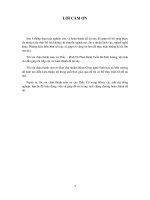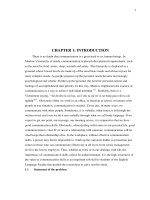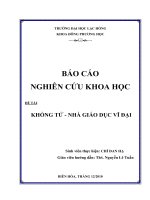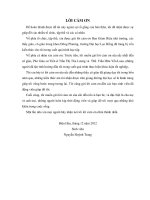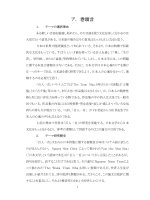Báo cáo nghiên cứu khoa học: "Application SDOF model to seismic base sliding analysis of concrete gravity dams subjected to earthquake load" pot
Bạn đang xem bản rút gọn của tài liệu. Xem và tải ngay bản đầy đủ của tài liệu tại đây (185.27 KB, 7 trang )
Application SDOF model to seismic base sliding analysis of
concrete gravity dams subjected to earthquake load
MEng.Trinh Quoc Cong; Prof. Dr. Zhang LiaoJun; MEng. Gong Cunyan
College of Water Conservancy and Hydropower Engineering, Hohai University, Nanjing, China
1. Introduction
Concrete gravity dams are typically constructed in blocks separated by vertical contraction joints. The design
of straight concrete gravity dams is traditionally performed by assuming each block to be independent.
Understanding the 2-D behaviour of individual monoliths is thus considered relevant and 2-D models are usually
employed in safety evaluations of existing dams. During a strong seismic event, low to medium height concrete
gravity dams tend to crack at the base which attract high stresses. The state-of-the-practice in the seismic
evaluation of concrete gravity dams requires that the failure mode of the dam monolith sliding at its base must be
considered.
It is well recognized that the pseudo-static loads determined on the basis of a seismic coefficient are very
small when compared to the actual forces expected in a gravity dam during a strong earthquake [1]. Therefore, it
is highly unlikely that the traditional safety criteria [2]
;
for sliding stability can be satisfied if the pseudo-static
lateral forces were to represent the true dynamic forces acting on a dam during a moderate to intense
earthquake. However, the evaluation of seismic sliding safety on the basis of static loads has little meaning in the
context of the oscillatory nature of earthquake loading and the corresponding dam response. Therefore, the
normal criteria for evaluating static stability may not be appropriate to evaluate the seismic stability of concrete
gravity dams. During an earthquake, as the forces acting on the dam change with time, it is desirable to assess
the stability criteria at various time instants during the entire duration of the earthquake. Of particular importance
is the evaluation of the critical earthquake accelerations at which the sliding of a dam could be expected.
In this paper, a numerical model to simulate seismic base sliding of concrete gravity dams preloaded by a
constant horizontal force and subjected to base excitations is developed. The method bases on the assumption
that the dam is considered as a block resting on a rigid foundation. It is called single degree of freedom method
(SDOF). As the verification, results of present study are compared with results of experimental model carried out
by MIR and Taylor
[3]. Follow from this, the method is applied to analyze base sliding ability of Suoisap dam.
2. SDOF numerical model
The model SDOF considered concrete gravity dam as a block with mass M resting on rigid foundation. The
dam is preloaded by a horizontal hydrostatic force H
st
,
uplift load and subjected to a base motions caused by
earthquake.
The solution to the problem is based on the following assumptions:
- The dam and foundation are rigid;
- The dam - foundation interaction is horizontal;
- There is no mutual bond between the dam and the foundation and the motion is resisted by pure friction at
the interface;
- The dam and foundation are always in contact, which means that any jumping or rocking motions of model
is not considered;
- No cohesion between the dam and foundation is considered.
At any instant of time the dam is in equilibrium under a set of six forces:
- The weight of the dam, Mg, acting vertically downwards;
- The hydrostatic force, H
st
, acting horizontally in or against the direction of motion;
- The frictional force, F
r
=
Mg, acting against the direction of motion;
- The inertia force, Ma
(t)
, acting opposite to the direction of motion;
- The hydrodynamic force, H
d,
computed by using Westergaad’s added mass water;
- The uplift force U acting vertically upwards.
The critical horizontal acceleration
a
c
for inducing downstream sliding can be computed with the following
equation:
st
ao
c
HUW
MM
a
)(
)(
1
(1)
Where:
is frictional coefficient between dam and foundation.
M
ao
is the added water mass computed using Westergaad’s approach. According to Chopra and Zhang
[4]
,
the added water mass is computed as:
2
54.0 hM
ao
(2)
Where:
is the density of water and h is upstream water level.
When the ground acceleration is greater than a
c
, the dam is in motion, and the following dynamic equation of
equilibrium must be satisfied at each time step [5].
rdstao
FHHtMatSMM )()()(
(3)
Where
S
is the sliding acceleration of the dam.
Equation (3) can be written:
ao
st
MM
UMgH
tatS
(
)()(
(4)
Newmark
[5]
linear acceleration step-by-step scheme was used to compute sliding velocity and displacement.
Within a time step h, delimited by the initial point with the subscript i, and the final point with the subscript i+1, the
variation of the sliding acceleration
S
after the time
is obtained with the following equation:
h
SS
SS
ii
i
1
)(
(5)
The sliding velocity
.
S
and sliding displacement S are given respectively by equations (6) and (7)
)(
2
1
1
.
iiii
SS
h
SS
(6)
63
2
1
2
1
h
S
h
ShSSS
iii
ii
(7)
Once sliding is instigated, it will only stop if two conditions are met:
+ The horizontal acceleration is inferior to the critical acceleration and.
+ The sliding velocity at the end of a time step is negative.
When both conditions are met, the rigid body falls in stick mode, and a correction is added to the previous
time step displacement. The correction takes in account that during a time step where at the end the velocity is
computed negative, a certain amount of sliding occurs before the velocity becomes negative. As can be noted in
Figure 1, the amount of sliding that must be added is that which occurs during the h
a
portion of the time step h.
S(t)
t
t
S
i
a
S =0
h
S
i+1
S(t)
h
a
S
i
i+1
S
S
a
Figure 1.
Correction of displacement
Referring to equations (5), (6) and (7), and putting the velocity
a
S
.
equal to O at the h
a
, we can express h
a
in
the following manner:
ai
i
a
SS
S
h
.
2
(8)
From figure (1) and equation (8), the value
a
S
is obtained with the following equation:
h
SS
SSS
ii
iia
1
.
2
2
(9)
Having established
a
S
, from equation (7), the correction to be added to the sliding displacement, S
cor
, is
computed:
63
2
1
2
a
i
a
i
a
i
h
S
h
ShSScor
(10)
Base on algorithm above, The DAS computer program was developed in this study to assess the
downstream sliding of rigid concrete gravity dams subjected earthquake loads. The main menu of DAS program
is showed in figure 2.
Figure 2.
The main menu of DAS program
3. Verification of model
As the verification, the result of the DAS program is compared with result taken from experimental model
carried out by (R.A.MIR and C.A. TAYLOR 1996)
[3]
. The details of the experimental model monolith are shown in
Figure 3.
248692
30
370160
100
10
All dimensions in mm
Model
Tank
Base
ELEVATION
Rubber membrane
PLAN
230
400
200
1100
1500
Figure 3.
Experimental set-up taken from reference
In the case of dams, an important factor that influences the sliding response is the hydrostatic pressure
acting on the upstream face of the dam. It was, therefore, important that this pressure was reasonably
represented in the experiments. A considerable effort was needed to develop a reasonable arrangement for the
simulation of hydrostatic pressure. A rigid rectangular steel tank (Figure 3) of 0.230m x 0400 m cross- section
and 1.1m height was used for this purpose. The side of the tank adjacent to the upstream face of the dam was
designed to consist of a watertight, flexible rubber membrane having sufficient slack to keep the hydrostatic
pressure on the model engaged even if the model were to move up to 40mm downstream.
The measured coefficient of static friction at the dam-foundation interface was 0.72. The mass of the dam
model was 186 kg and the height of the water in the tests was 0.95m. The input motion was a sine function of 5
HZ frequency having an initial rising ramp for 5 cycles followed by a 10cycle constant amplitude motion and
finally a decaying ramp for another 5 cycles of motion as shown in Figure 4. The results of both SDOF model and
experimental model are shown in Figure 5.
1 2 3 4 5 6
-6
-4
-2
0
2
4
6
Acceleration (m/s2)
T im e (S e c )
Figure 4.
Sine dwell input
1 2 3 4 5 6
0.000
0.001
0.002
0.003
0.004
0.005
0.006
0.007
Displacement (m)
Time (sec)
a)
b)
Figure 5.
Displacement of dam; a) From DAS program; b) From experiment model
From figure 5, it is observed that the displacements of dam block calculated by DAS program and taken
from reference are almost similar. The total displacement calculated by DAS program is 6.4mm while the total
displacement of dam taken from experimental model is 6.9mm.
4. Seismic sliding analysis of Suoisap dam
Suoisap dam is being built in Suoisap stream a branch of Da river, Sonla province. The dam is 35 m in
height. The trapezoidal section of the dam is 5 m wide at the top and 30m at the base. The reservoir level is 29
m above the base of the dam. The loads considered in the analyses are the self - weight, the hydrostatic forces
acting horizontally on the upstream face of the dam, the uplift force acting at the base of the dam and the
earthquake load. The uplift force was computed using trapezoidal shape of uplift pressure with 29m of water
pressure upstream and 12.5m downstream to account for the pressure induced by flow through the opening. The
dynamic excitation considered in this paper is the acceleration spectrum given by the Vietnam code for seismic
1 2 3 4 5
0.000
0.001
0.002
0.003
0.004
0.005
0.006
0.007
Displacement (m)
Time (Sec)
design of construction [6]
(figure 6). The history corresponding artificial acceleration curve is computed from the
acceleration spectrum correlatively by utilizing SIMQKE program. The result of displacement of the dam is shown
in figure 7. The total displacement of the dam is 18mm.
0 1 2 3 4
0
1
2
3
4
Acceleration (m/s2)
Period (s)
a) b)
Figure 6.
Dynamic excitation a) Design Spectrum; b) Time history acceleration
0 2 4 6 8 1 0 1 2 1 4 1 6
0 .0 0 0
0 .0 0 5
0 .0 1 0
0 .0 1 5
0 .0 2 0
Displacement (m)
T im e ( se c )
Figure 7.
Displacement of Suoidap Dam
5. Conclusions
A method is proposed for the dynamic base sliding analysis of concrete gravity dams. The method based on
the assumption that the dam is considered as a block resting on a rigid foundation. A computer program was
developed to analyze seismic base sliding of concrete gravity dam. The result of this program is in close
agreement with the result of the experimental model taken from reference.
The method in this study is suitable for base sliding analysis of low to medium height gravity dams, around
20-60m height. In general, dams of this height have relatively high fundamental frequencies, which tend to be
outside the dominant frequency range of most earthquakes. Therefore, the use of a rigid dam model is
reasonable simplification for dams of thi height.
References
1. A. K.
Chopra
. Earthquake behaviour of reservoir-dam systems;
J. eng. mech. din, ASCE 94, 1475-1500, 1968.
2. U.S. Bureau of Reclamation; Design of gravity dams: Design Manual for Concrete Gravity Dams;
Denver, Colorado;
1976.
3.
R. A. MIR
and C. A. TAYLOR. An investigation in to base sliding response of rigid gravity dams to dynamic load.
Earthquake engineering and structural dynamic, Vol.25, 1996.
4. CHOPEU, A.K., and ZHANG, L. Earthquake-Induced Base Sliding of Concrete Gravity Dams;
ASCE Journal of
0 2 4 6 8 10 12 14 16
-2
-1
0
1
2
Acceleration (m/s2)
Time (s)
Structural Engineering, 117 (12): 3698-37, 1991
.
5. Ani K. Chopra
. Dynamics of structures: Theory and applications to Earthquake Engineering (Second Edition).
Prentice-Hall, 844, 2001.
6. TCXDVN 375 : 2006. ThiÕt kÕ c«ng tr×nh chÞu ®éng ®Êt (Vietnam Construction standard, TCXDVN 375:2006: Design of
seismic resistant structures).

